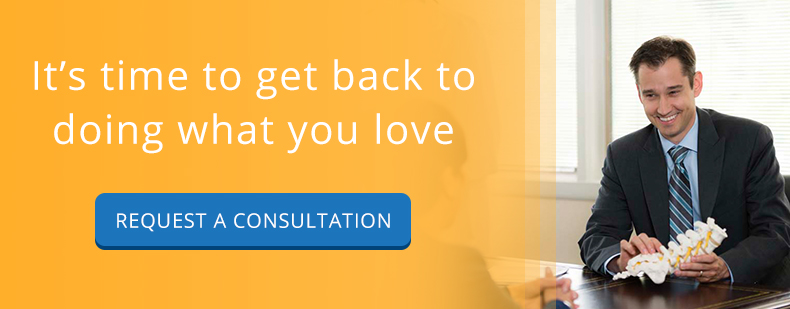Are you seeking spinal stenosis treatment in NJ? A definitive diagnosis of spinal stenosis can make a huge difference in receiving the proper treatment. According to The 5-Minute Clinical Consult 2011,1 approximately 8% of people have this potentially debilitating condition. It’s important to understand spinal stenosis, possible treatment options and how to get the best treatment available.
What is spinal stenosis?
Spinal stenosis is the medical term for the narrowing of your spinal canal. Your spinal canal is the hollow inner portion of your spine where the spinal cord and nerves reside.
Symptoms
When this condition occurs, you may experience few if any symptoms or they may be incapacitating at times. The majority of individuals with symptomatic spinal stenosis experience one or more of the following symptoms. These can vary depending on what region of the spine the stenosis is occurring in.
- Discomfort while standing for any period of time
- Numbness in your hands, arms, legs or feet (this occurs below the area where the stenosis is present)
- Pain in your shoulder, arm or hand
- Bowel or bladder control issues
- Compromised fine motor skills and coordination
- Occasionally, symptoms will occur on both sides of your body
Causes
A number of issues can cause spinal stenosis. These can include spinal tumors, osteoarthritis, trauma or spinal injury, rheumatoid arthritis, scoliosis, Paget’s disease, spondylolisthesis, bone spurs or achondroplasia.
Diagnosing spinal stenosis
There are a number of means by which spinal stenosis can be diagnosed. In most cases it is discovered after one or more of the above-mentioned symptoms is experienced. In some instances, it is what is known as an incidental finding (this is most common in asymptomatic individuals). This means that diagnostics were being performed for another reason and the stenosis was found during that process.
The most commonly used diagnostic techniques to evaluate the spine include x-rays, to evaluate the overall structure of the spine and rule out major deformities, as well as more advanced imaging techniques such as CT scans and MRIs to hone in on the finer details of the spinal canal, spinal nerves, and spinal cord. These more advanced imaging techniques are required to confirm the diagnosis of spinal stenosis and its location.
Treatments for Spinal Stenosis
Once you’re ready to seek your spinal stenosis treatment in NJ, it’s important to have a spinal doctor you trust. A good doctor or surgeon will be able to guide you through the process of choosing the best treatment options and help you find facilities near your home in New Jersey or the Tristate area so you won’t have to travel too far.
The treatment options for spinal stenosis include non-surgical and surgical methods. Depending on the severity of your spinal stenosis and its location, you may be started on the most conservative treatment or be referred for surgery.
Non-surgical spinal stenosis treatments
Your doctor will likely recommend you start with a more conservative course of action for treating your spinal stenosis. Depending on your individual needs and the location of your stenosis, these may include everything from medications, physical therapy, to various injections.
Pain medications
Mild spinal stenosis symptoms often respond well to pain medications. Your doctor may recommend you try over-the-counter analgesics and anti-inflammatories, such as acetaminophen or ibuprofen. If these don’t seem to be taking care of the pain, you may be prescribed a stronger pain medication.
Injections
Corticosteroid injections in the area of your stenosis may reduce inflammation enough to allow you to be symptom-free. This involves a pain management specialist injecting a cortisone-based steroid at the point of the stenosis.
Exercise/physical therapy
Although it seems counter-intuitive, exercise can have positive effects on spinal stenosis. By stretching and strengthening ligaments and muscles in and around the affected area, you are essentially providing greater support to the affected area, creating more flexibility and allowing your body to move more freely.
Massage
Because spinal stenosis can cause stiffness and overall aches and pains, massage can be a useful tool to help alleviate some of the symptoms of this condition.
Surgical spinal stenosis treatments
If non-surgical treatments don’t work or aren’t effective enough at resolving your symptoms, surgery is the next option.
The procedures used to treat spinal stenosis are laminectomy, which may be performed by itself, or in conjunction with a spinal fusion.
To perform the laminectomy, a segment of the vertebra is removed, creating more room for the nerves that are being affected. In some cases, bone spurs (such as those that develop in conjunction with osteoarthritis) and ligaments may be removed to help further open up the area.
If a laminectomy requires the removal of a large portion of bone or it’s determined the spine is unstable, a spinal fusion may be performed. This involves inserting metal instrumentation such as rods, plates, wires or screws to join the adjacent bones and create more stability. In addition, bone grafting material is placed to create a “bridge” of bone, providing a more solid support for the area of the laminectomy.
How to Get Top-Quality Treatment
Finding the right doctor to perform your spinal stenosis treatment in NJ can be a complex process. However, if you take certain steps in your search, you’ll find the right doctor for your individual treatment. Consider the following qualities and attributes when you’re vetting various spinal stenosis doctors.
- Ensure that your doctor is fully accredited. This includes holding a board certification in neurosurgery or orthopedic surgery, preferably with dedicated training in spinal surgery. With these credentials, you can rest assured that they have the best training and experience in their field.
- Make sure that your doctor listens to you. If he or she doesn’t seem to be engaged and focused on you and your issues and concerns, keep looking. Your health and well-being need to be the two most important things your doctor is thinking about while talking with you.
- A doctor with a good bedside manner is also essential. Find a doctor that is kind, caring and genuinely interested in helping you get the best treatment possible.
It’s also very helpful to find a doctor close to home. If you live in the New Jersey or tri-state area, look for a board-certified doctor that practices close to you. The less energy you have to focus on making travel arrangements, the more you can keep your eye on the important task at hand — finding a great doctor and getting relief from your spinal stenosis!
1 Domino, F. J. (2011). The 5-minute clinical consult 2011. Philadelphia, PA: Lippincott Williams & Wilkins.


